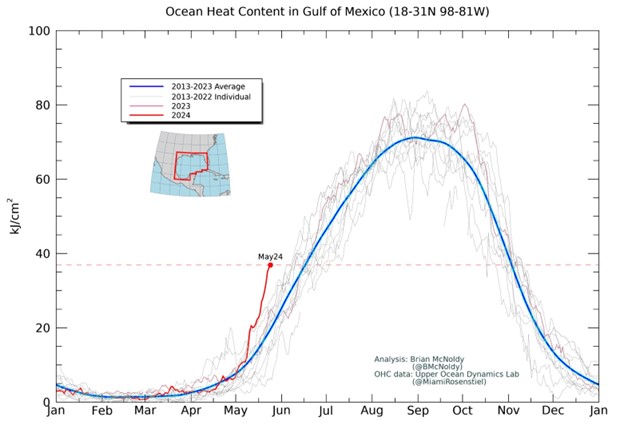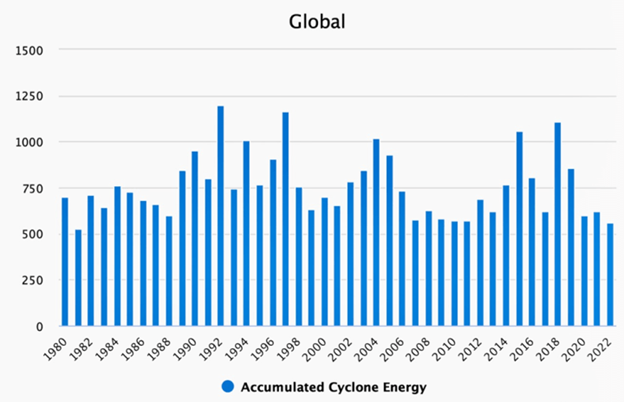The mainstream media is hyping the National Oceanic and Atmospheric Administration’s (NOAA) annual hurricane Season forecast released on May 23rd, that projects significantly above normal hurricane season is to be expected in the Atlantic. For example, these headlines: NBC News, NOAA issues highest-ever early forecast for the coming hurricane season; the New York Times, 2024 Hurricane Season Is Expected to Be Abnormally Busy, NOAA Predicts; and Huffington Post, NOAA Issues Its Most Aggressive Storm Forecast Yet Ahead Of Hurricane Season. The 2024 hurricane season may or may not wind up above average, but based on the same kind of forecasts and reporting in 2022, which failed to materialize, there is a good chance that these predictions and headlines will prove to be big on hype and low on accuracy.
NOAA’s press release says this:
NOAA National Weather Service forecasters at the Climate Prediction Center predict above-normal hurricane activity in the Atlantic basin this year. NOAA’s outlook for the 2024 Atlantic hurricane season, which spans from June 1 to November 30, predicts an 85% chance of an above-normal season, a 10% chance of a near-normal season and a 5% chance of a below-normal season.
NOAA is forecasting a range of 17 to 25 total named storms (winds of 39 mph or higher). Of those, 8 to 13 are forecast to become hurricanes (winds of 74 mph or higher), including 4 to 7 major hurricanes (category 3, 4 or 5; with winds of 111 mph or higher). Forecasters have a 70% confidence in these ranges.
Infographic: NOAA National Hurricane Center
If that forecast comes true it would in fact be a very busy season with the potential for devastating storms along the United States and Caribbean coastlines.
Many reports suggest a busier than normal season because ocean heat content in the main region of the Atlantic is running ahead of schedule for this time of year. Hurricanes thrive on heat from the ocean, so forecasters are expecting quick development.
The current ocean heat content in the Atlantic Main Development Region for hurricanes is currently running about 2.5 months ahead of schedule according to this analysis by Brian McNoldy at the University of Miami Rosenstiel School, seen in Figure 1 below.

Figure 1. Ocean Heat content in 2024 as of May 24th compared to the 2013-2023 average.
NOAA latches onto this heated development adding in their press release:
As one of the strongest El Ninos ever observed nears its end, NOAA scientists predict a quick transition to La Nina conditions, which are conducive to Atlantic hurricane activity because La Nina tends to lessen wind shear in the tropics. At the same time, abundant oceanic heat content in the tropical Atlantic Ocean and Caribbean Sea creates more energy to fuel storm development.
But despite the predictions of a fast and furious potential for more hurricanes this year Mother Nature isn’t cooperating, so far. Philip Klotzbach, Ph.D., a hurricane specialist at the University of Colorado notes that expected development has stalled:
The Northern Hemisphere has yet to have its first named storm (e.g., tropical storm or hurricane) in 2024. This is the first time since 1983 that the Northern Hemisphere has gone this late in the calendar year without a named storm.
The early forecasts and media coverage have a feeling of 2022, “deja vu all over again.” Climate Realism brought attention to the early overhyped claims and the failures of the media in covering the 2022 Atlantic hurricane season here, here, and here. When it was all over, we reported Despite Predictions, 2022 Atlantic Hurricane Season Fizzles Out Below ‘Normal’. After nearly 4 decades of climate agenda driven claims of worsening global climate impacts from hurricanes, NOAA’s measured worldwide hurricane season data for all year 2022 tropical storms showed that global wide storms were at their lowest strength levels in the last 42 years as seen in Figure 2 below.
Figure 2: The year 2022 global wide ACE data outcome is about 29% lower than the average over the 30 year-long (1991 through 2020) climatology period tracked by Colorado State University’s Tropical Meteorology Project database.
To say that the predictions and media coverage of the 2022 hurricane season was an epic failure is an understatement.
Yet, here we are, two years later with the same sort of predictions and media hype unfolding again. In 2022, NOAA said this:
The increased activity anticipated this hurricane season is attributed to several climate factors, including the ongoing La Niña that is likely to persist throughout the hurricane season, warmer-than-average sea surface temperatures in the Atlantic Ocean and Caribbean Sea, weaker tropical Atlantic trade winds and an enhanced west African monsoon.
Sound familiar? Only time will tell, but given the poor track record of the past, there’s a good chance that NOAA and the media will have egg on its collective face again at the end of 2024. One thing we can say for certain when it comes to hurricanes, despite constant assertions that climate change is making them worse, data shows that there is no long-term trend of either increasing hurricane frequency or hurricanes becoming more powerful.




















